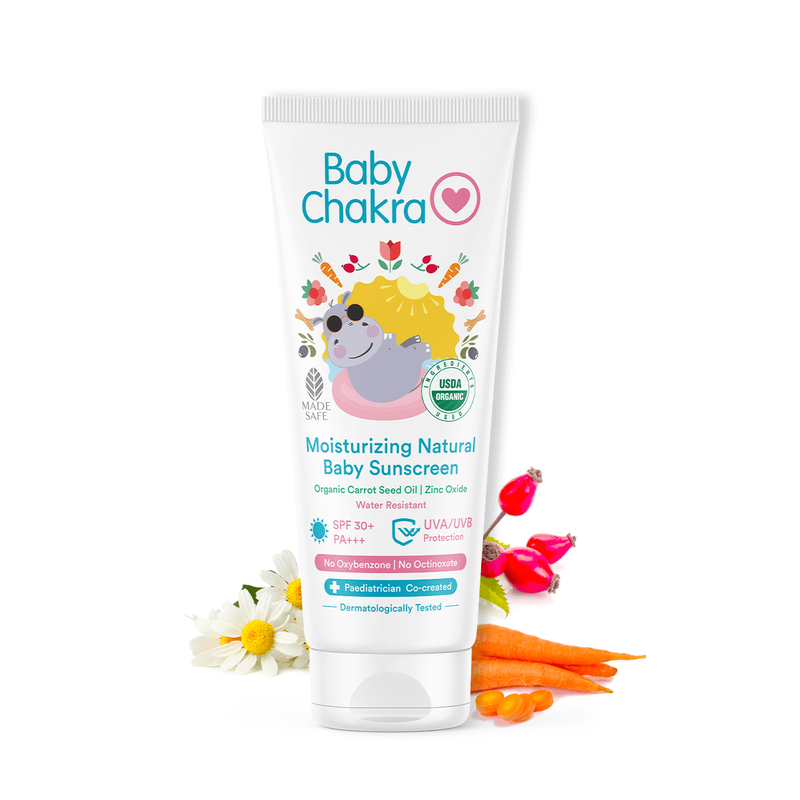
Does Your Child’s Sunscreen Have Oxybenzone? Discontinue Right Away. Here’s Why!
15 Feb 2023 | 3 min Read
Manisha Pradhan
Author | 1053 Articles
Sunscreens are an important part of the skincare routine for kids. It protects their skin from the damaging effects of ultraviolet (UV) radiation, which can lead to skin issues like skin cancer, and other health problems.
However, some sunscreens contain oxybenzone, a chemical that has been linked to potential health risks, especially in children.
Why Is Sunscreen With Oxybenzone Harmful For Kids?
Oxybenzone is a common ingredient in many sunscreens, as it absorbs UV rays and helps to prevent sunburn. However, studies have shown that oxybenzone can be absorbed through the skin and into the bloodstream, where it may have harmful effects on our bodies.
Disrupts hormone levels
One concern is that oxybenzone can disrupt hormone levels in the body, especially in children. Hormones are chemical messengers that regulate many of our body’s functions, including growth, development, and reproduction. Oxybenzone has been shown to mimic the effects of the hormone estrogen, which can disrupt the natural balance of hormones in the body.
In children, exposure to hormones can have long-lasting effects on their development and health. For example, exposure to excess estrogen in early childhood can increase the risk of breast cancer later in life. Other health problems linked to hormonal disruptions include the early onset of puberty, decreased fertility, and obesity.
Causes Skin Allergies
In addition to its hormonal effects, oxybenzone has been shown to cause skin allergies in some people. It can also cause skin irritation and rashes, which can be especially problematic for children who may have more sensitive skin than adults.
Increased sun sensitivity
Oxybenzone may increase the skin’s sensitivity to the sun, making children more prone to sunburn and skin damage.
Furthermore, oxybenzone is toxic to coral reefs and other marine life. When people swim in the ocean or other bodies of water, oxybenzone from sunscreen can be washed off the skin and into the water, where it can harm the delicate ecosystems that exist there.
Coral reefs, in particular, are especially vulnerable to the effects of oxybenzone, as it can cause coral bleaching and disrupt the growth and reproduction of these vital organisms.
For all these reasons, many experts recommend that parents avoid using sunscreen with oxybenzone on their children. Instead, they suggest using natural mineral-based sunscreens with physical blockers such as zinc oxide.
They work by reflecting UV rays away from the skin instead of absorbing them. These physical blockers are generally considered safe and effective and do not have the same hormonal or environmental concerns as oxybenzone.
In addition to using sunscreens with physical blockers, parents can also take other measures to protect their children from the harmful effects of UV radiation. These include staying in the shade during the hottest parts of the day, and wearing protective clothing such as hats and long-sleeved shirts.
Sunscreens that contain oxybenzone may pose potential health risks, especially for children, due to their hormonal effects, skin irritation, and harm to marine life. As a result, parents should opt for sunscreens with physical blockers instead and take other measures to protect their children from UV radiation. By doing so, they can help to keep their children safe and healthy while enjoying the great outdoors.
Cover image source: freepik
A


Related Topics for you
Suggestions offered by doctors on BabyChakra are of advisory nature i.e., for educational and informational purposes only. Content posted on, created for, or compiled by BabyChakra is not intended or designed to replace your doctor's independent judgment about any symptom, condition, or the appropriateness or risks of a procedure or treatment for a given person.

